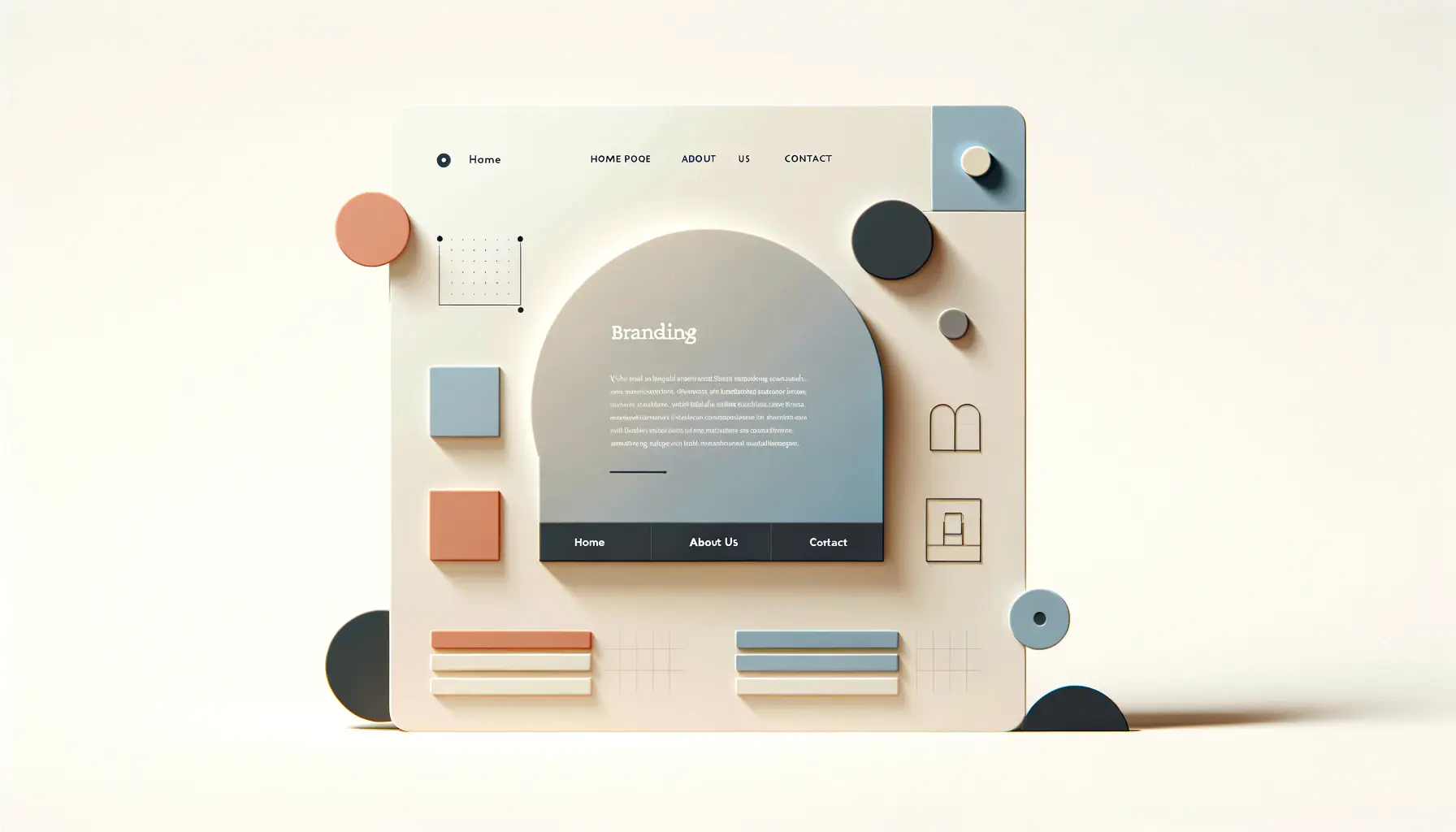In today’s digital age, the importance of a strong online presence cannot be overstated.
A well-designed website serves as the cornerstone of any brand’s digital strategy, offering a unique opportunity to showcase its identity and connect with a broader audience.
The concept of maximizing visibility through effective web design branding encompasses more than just aesthetic appeal; it involves creating a seamless, user-friendly experience that resonates with visitors and encourages engagement.
This approach not only enhances brand recognition but also plays a crucial role in converting casual browsers into loyal customers.
At the heart of effective web design branding lies the understanding that every element of your website – from typography and color schemes to layout and content – should be thoughtfully aligned with your brand’s core values and objectives.
This strategic alignment ensures that visitors not only remember your brand but also associate it with positive experiences.
In an increasingly competitive online marketplace, businesses that succeed in creating a distinctive and memorable web presence are those that understand the power of branding in web design.
- The Role of SEO in Web Design Branding
- Visual Elements and Their Impact on Brand Perception
- Content Strategy and Its Role in Engagement
- Enhancing User Experience with Intuitive Navigation
- Building Trust Through Visual Storytelling and Brand Consistency
- Leveraging Social Media Integration for Enhanced Engagement
- Analytics and Performance Tracking for Continuous Improvement
- Conclusion: The Synergy of Web Design Branding and Visibility
- FAQs on Maximizing Visibility Through Effective Web Design Branding
The Role of SEO in Web Design Branding
Integrating SEO with Web Design
Search Engine Optimization (SEO) and web design branding go hand in hand in maximizing a website’s visibility.
A visually appealing website is only effective if potential customers can find it.
Integrating SEO principles from the ground up ensures that your site ranks well on search engine results pages (SERPs), making it more accessible to your target audience.
This integration involves using relevant keywords, optimizing site speed, and ensuring mobile responsiveness, among other strategies.
Moreover, SEO-friendly web design extends beyond technical aspects to include content that is engaging, informative, and aligned with user intent.
By providing valuable content that meets the needs of your audience, you not only improve your site’s visibility but also establish your brand as a trustworthy authority in your industry.
This dual focus on aesthetics and functionality exemplifies the holistic approach required for effective web design branding.
Mobile Optimization and User Experience
In today’s mobile-first world, ensuring your website is optimized for mobile devices is non-negotiable.
Mobile optimization affects not only user experience but also SEO rankings.
Google’s mobile-first indexing means that the mobile version of your website is considered the primary version.
Therefore, a mobile-friendly website is essential for maximizing visibility.
This involves responsive design techniques that ensure your site looks and functions well on devices of all sizes, from smartphones to tablets and desktops.
Enhancing the user experience (UX) on mobile devices includes simplifying navigation, speeding up load times, and making interactive elements easily clickable.
A positive mobile UX encourages longer site visits and higher engagement rates, which in turn signal to search engines that your website is valuable to users, further boosting your SEO efforts.
By prioritizing mobile optimization and UX, businesses can significantly enhance their web design branding and visibility online.
Effective web design branding is a comprehensive strategy that combines aesthetics, functionality, and SEO to maximize online visibility and engage with the target audience.
Visual Elements and Their Impact on Brand Perception
The visual elements of a website, including its color scheme, typography, and imagery, play a pivotal role in shaping the brand’s perception.
These elements work together to evoke emotions, convey messages, and create a memorable brand experience.
A strategic approach to selecting and implementing these visual components can significantly enhance a brand’s visibility and appeal to its target audience.
Color psychology, for instance, is a powerful tool in web design branding.
Different colors can trigger various emotional responses and associations.
By carefully choosing a color palette that aligns with your brand’s personality and values, you can influence how visitors perceive and interact with your brand.
Similarly, typography and imagery should be selected with the brand’s identity and audience preferences in mind, ensuring a cohesive and engaging visual narrative.
Key Visual Elements in Web Design
- Color Scheme: The choice of colors should reflect the brand’s personality, whether it’s energetic and bold or calm and trustworthy. Colors have the power to affect mood and behavior, making this decision crucial for effective branding.
- Typography: Typography encompasses the fonts used on a website and how they contribute to the brand’s voice. The right typography enhances readability, user experience, and brand recognition.
- Imagery: High-quality, relevant images and graphics can communicate complex messages quickly and effectively. They also play a significant role in creating an emotional connection with the audience.
Creating a Cohesive Brand Experience
To maximize visibility and impact, every visual element on a website must be part of a cohesive brand experience.
This consistency ensures that visitors have a seamless interaction with the brand across all touchpoints, reinforcing brand recognition and loyalty.
From the logo and header design to the button styles and footer, every detail contributes to the overall brand narrative.
Moreover, a consistent visual identity across online and offline channels strengthens the brand’s market position.
It makes the brand easily identifiable in a crowded marketplace, enhancing its visibility and appeal to potential customers.
By meticulously crafting and maintaining a cohesive visual brand experience, businesses can significantly improve their web design branding and overall online presence.
A cohesive visual brand experience is crucial for effective web design branding, as it enhances brand recognition, fosters emotional connections, and ensures a seamless user experience across all platforms.
Content Strategy and Its Role in Engagement
Content is the backbone of any effective web design branding strategy.
It’s not just about filling your website with text; it’s about crafting valuable, relevant content that engages your audience and encourages interaction.
A well-thought-out content strategy can significantly boost a brand’s visibility by attracting more visitors, encouraging shares, and improving SEO rankings.
The key to a successful content strategy lies in understanding your audience.
By identifying their needs, preferences, and pain points, you can create content that resonates with them, solves their problems, and answers their questions.
This relevance is what will keep them coming back for more, turning casual visitors into loyal followers and customers.
Types of Content That Drive Engagement
- Blog Posts: Informative, well-written articles that provide value to your readers can establish your brand as an authority in your field.
- Videos: Engaging and visually appealing, videos can convey complex information in an easily digestible format, making them highly shareable.
- Infographics: These combine data and design to present information in an engaging, easy-to-understand way.
- Case Studies: Real-life examples of how your products or services have helped others can build trust and credibility.
Optimizing Content for SEO and User Experience
While creating compelling content is crucial, it’s equally important to optimize it for search engines and user experience.
This means using relevant keywords naturally, ensuring your content is easily scannable with headings and bullet points, and including calls to action that guide users to the next step.
Additionally, regularly updating your content keeps it fresh and relevant, encouraging repeat visits.
Another aspect of content optimization is making sure it’s accessible to all users, including those with disabilities.
This inclusivity not only broadens your audience but also improves your site’s SEO, as search engines favor websites that cater to a diverse user base.
A dynamic content strategy that prioritizes both SEO and user experience is essential for maximizing web design branding and engagement.
Enhancing User Experience with Intuitive Navigation
User experience (UX) is a critical component of web design branding that directly influences a website’s visibility and user engagement.
Intuitive navigation is at the heart of UX, guiding visitors smoothly from one page to another and ensuring they find what they’re looking for with minimal effort.
A website that is easy to navigate increases the likelihood of visitors staying longer, exploring more pages, and ultimately engaging with the brand.
Intuitive navigation involves a clear, logical layout of menus, a well-structured sitemap, and strategic placement of call-to-action (CTA) buttons.
These elements should be designed with the user’s journey in mind, anticipating their needs and facilitating their exploration of the website.
This user-centric approach not only enhances the user experience but also contributes to a positive brand perception.
Key Elements of User-Friendly Navigation
- Consistent Menu Structure: Keeping your navigation menu consistent across all pages helps users learn your site’s layout quickly.
- Clear CTA Buttons: CTAs should be prominently placed and clearly labeled to guide users towards desired actions, such as making a purchase or signing up for a newsletter.
- Search Functionality: Including a search bar allows users to find specific information quickly, improving the overall usability of your site.
- Breadcrumb Navigation: This feature helps users understand their current location within your website and easily navigate back to previous pages.
Optimizing for Mobile Users
With the increasing use of smartphones for internet access, optimizing navigation for mobile users is essential.
This means designing responsive menus that adapt to smaller screens, ensuring touch targets are large enough to be tapped easily, and minimizing the need for horizontal scrolling.
Mobile optimization not only improves the user experience for a significant portion of your audience but also positively impacts your website’s SEO rankings, as search engines favor mobile-friendly sites.
By prioritizing intuitive navigation and mobile optimization, businesses can significantly enhance their web design branding, making their website more accessible, user-friendly, and appealing to both desktop and mobile users.
This focus on UX is a key factor in building a strong online presence and fostering positive interactions with your brand.
Intuitive navigation and mobile optimization are fundamental to creating a positive user experience, directly impacting a brand’s visibility and engagement online.
Building Trust Through Visual Storytelling and Brand Consistency
Visual storytelling and brand consistency are powerful tools in the arsenal of web design branding.
They work together to build trust with your audience by creating a cohesive brand narrative that resonates on an emotional level.
Visual storytelling uses images, videos, and other visual elements to convey your brand’s story, values, and personality, making your message more engaging and memorable.
Brand consistency across all platforms reinforces this message, creating a strong, unified brand identity that fosters trust and loyalty among your audience.
Trust is a critical component of any successful online presence.
When visitors feel connected to your brand through compelling visual storytelling and encounter a consistent brand experience across all touchpoints, they are more likely to trust your brand.
This trust translates into higher engagement rates, increased conversions, and, ultimately, brand loyalty.
Implementing Visual Storytelling in Web Design
- Use High-Quality Imagery: Choose images that reflect your brand’s ethos and connect with your audience on an emotional level.
- Incorporate Videos: Videos are an effective way to engage users and provide a deeper insight into your brand’s story and offerings.
- Infographics and Icons: These visual elements can simplify complex information, making it more accessible and engaging for your audience.
Maintaining Brand Consistency Across Platforms
- Unified Visual Identity: Ensure your website, social media profiles, and offline materials share a consistent color scheme, typography, and logo usage.
- Consistent Tone of Voice: The language and tone used in your content should reflect your brand’s personality consistently across all channels.
- Cohesive User Experience: From your website to your mobile app, the user experience should be seamless and reflective of your brand’s values.
By weaving visual storytelling into the fabric of your web design and maintaining brand consistency across all platforms, you can create a compelling brand narrative that captivates and retains your audience.
This strategic approach not only enhances your brand’s visibility but also establishes a foundation of trust and credibility that is essential for long-term success in the digital marketplace.
Visual storytelling and brand consistency are key to building trust and creating a memorable brand experience that enhances visibility and fosters user engagement.
Leveraging Social Media Integration for Enhanced Engagement
Social media integration into web design branding is a strategic approach to enhance engagement and extend the reach of your brand.
By incorporating social media elements directly into your website, you provide visitors with a seamless way to connect with your brand across multiple platforms.
This not only amplifies your content’s reach but also encourages social sharing, increasing your brand’s visibility and attracting new followers.
Effective social media integration goes beyond simply adding social media icons to your website.
It involves creating opportunities for visitors to engage with your content and share it within their networks.
This can significantly boost your brand’s presence online, driving more traffic to your site and enhancing user engagement.
Strategies for Social Media Integration
- Share Buttons: Include social share buttons on blog posts, product pages, and other shareable content to make it easy for visitors to spread the word about your brand.
- Social Feeds: Embedding your brand’s social media feeds on your website keeps content fresh and encourages visitors to follow your social media profiles.
- User-Generated Content: Showcase user-generated content from social media on your website to build community and authenticity around your brand.
Benefits of Social Media Integration
- Increased Visibility: Social sharing extends your content’s reach, exposing your brand to a wider audience.
- Enhanced SEO: Social signals can indirectly impact your SEO rankings by driving more traffic to your website.
- Greater User Engagement: Social media integration encourages interaction, keeping users engaged with your brand across multiple platforms.
Integrating social media into your web design branding strategy is a powerful way to leverage the vast reach and engagement potential of social platforms.
By making it easy for users to connect with your brand and share your content, you can significantly enhance your online presence, foster a sense of community, and drive meaningful engagement.
This holistic approach to digital branding ensures that your brand remains relevant and visible in the ever-evolving digital landscape.
Social media integration is a crucial element of modern web design branding, offering a direct channel to engage with your audience and amplify your brand’s online visibility.
Analytics and Performance Tracking for Continuous Improvement
Analytics and performance tracking are indispensable tools for any web design branding strategy aiming to maximize visibility.
By closely monitoring how users interact with your website, you can gather valuable insights into what works and what doesn’t.
This data-driven approach allows for continuous improvement of your website’s design, content, and user experience, ensuring that your brand remains competitive and relevant in the digital space.
Implementing analytics tools such as Google Analytics provides a wealth of information, from which pages attract the most visitors to how long people stay on your site.
Understanding these metrics is crucial for optimizing your website to better meet the needs of your audience and improve your search engine rankings.
Key Metrics to Monitor
- Traffic Sources: Identifying where your visitors are coming from helps you understand which marketing efforts are most effective.
- User Behavior: Tracking how users navigate your site can reveal insights into their preferences and pain points.
- Conversion Rates: Measuring how many visitors take a desired action (e.g., making a purchase, signing up for a newsletter) can indicate the effectiveness of your website’s design and content.
Utilizing Feedback for Optimization
Beyond analytics, actively seeking and incorporating user feedback is vital for refining your web design branding strategy.
User surveys, feedback forms, and social media interactions can provide direct insights into what users like and dislike about your website.
This qualitative data complements the quantitative data from analytics, offering a more comprehensive view of your website’s performance.
Armed with this information, you can make informed decisions about design changes, content updates, and new features to enhance user experience and engagement.
Regularly updating your website based on analytics and user feedback not only improves its performance but also signals to visitors that you value their input and are committed to providing a superior online experience.
Ignoring analytics and user feedback can lead to missed opportunities for optimization and growth, hindering your brand’s visibility and engagement online.
Conclusion: The Synergy of Web Design Branding and Visibility
In the digital age, maximizing visibility through effective web design branding is not just an option; it’s a necessity for businesses aiming to thrive online.
The journey towards creating a visible and impactful online presence is multifaceted, involving strategic integration of SEO, mobile optimization, visual storytelling, and consistent brand messaging.
Each element plays a crucial role in attracting and retaining a loyal audience, ultimately contributing to the brand’s success.
Key Takeaways for Maximizing Visibility
- SEO and mobile optimization are foundational to ensuring your website is discoverable and accessible to a broad audience.
- Visual elements and storytelling are powerful tools for engaging users and fostering an emotional connection with your brand.
- Content strategy, driven by quality and relevance, is essential for engaging and retaining visitors, turning them into brand advocates.
- Intuitive navigation enhances the user experience, encouraging longer visits and deeper engagement with your website’s content.
- Social media integration extends your brand’s reach, leveraging the power of networks to amplify your visibility.
- Analytics and performance tracking enable continuous improvement, ensuring your web design branding efforts remain effective and aligned with user expectations.
As we navigate the complexities of the digital landscape, it’s clear that a holistic approach to web design branding is key to maximizing visibility.
By embracing these strategies, businesses can create a compelling online presence that resonates with their target audience, drives engagement, and fosters long-term loyalty.
The journey towards enhanced visibility is ongoing, requiring constant innovation, adaptation, and a deep understanding of the evolving digital environment.
However, with the right approach, the rewards are significant, offering businesses the opportunity to stand out in a crowded marketplace and achieve lasting success.
Quality web design is key for a great website! Check out our service page to partner with an expert web design agency.
FAQs on Maximizing Visibility Through Effective Web Design Branding
Discover essential insights into enhancing your brand’s online presence through strategic web design and branding efforts.
Web design branding involves creating a unique online identity through visual elements, content, and user experience that reflect a brand’s values and goals.
SEO optimizes your website to rank higher in search engine results, making it more visible to potential customers searching for related keywords.
Mobile optimization ensures your website is accessible and user-friendly on mobile devices, catering to the growing number of mobile internet users.
Yes, integrating social media can drive traffic to your website by encouraging shares and engagement across social platforms.
Content communicates your brand’s message and values, engages your audience, and supports SEO efforts to improve visibility.
User experience is vital for retaining visitors and converting them into customers by ensuring your website is easy to navigate and interact with.
Visual storytelling captures attention, evokes emotions, and makes your brand more memorable, enhancing user engagement.
Analytics provide insights into user behavior and website performance, guiding continuous improvement and optimization of your web design branding strategy.













